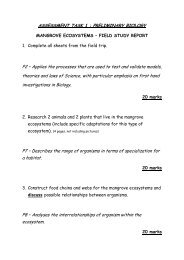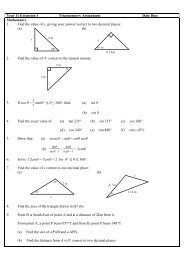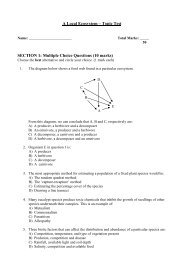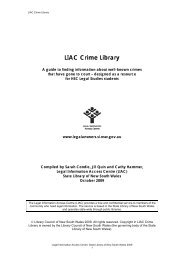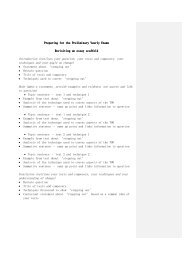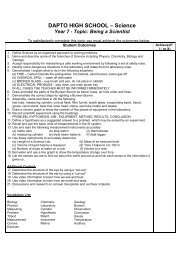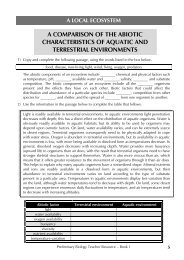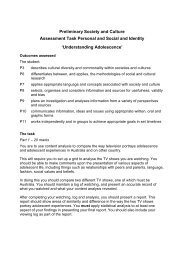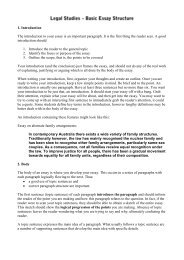<strong>Swimming</strong> <strong>Upstream</strong>“By the ‘50’s the local pool was fast being regarded as an essential communityvenue for accessible and safe sport, education and leisure...”The Australian Aug 2-3 2008This is a film about a boy who, in his enjoyment of piano, books, and success at school, mustfind a way to gain his father’s attention and respect, and to achieve his dream “to besomebody...” – through swimming. 1 While he has success, his father’s insatiable, passionateneed to have his dream through others’ achievements drives Tony Fingleton from his belovedbrother John, his childhood mate and confident, and eventually leads him leaving his family andcountry.The film is set in the 1950’s – Menzies was Prime Minister, Australia was recovering from thewar, with a time of relative peace and stability (apart from the Korean War) but there was anincreasing fear coming from the nuclear threat and the Cold War between America and Russia.It was a patriarchal society, where women stayed at home and supported their husbands nomatter what, and women such as the independent Billie were the minority. The adultpopulation was investing its hopes for peace and prosperity with the post-war generation.But with progress there came problems – on the wharves, for instance, increasingmechanisation meant fewer jobs, and so we have the background for the beginning of RussellMulcahy’s <strong>Swimming</strong> <strong>Upstream</strong>.In our study we will examine some experienced that bring about change in a person’s life. Notethat while others in the film must inevitably change as a result of the father’s dominance, ourfocus is on Tony Fingleton.We will examine closely certain techniques used by Mulcahy to convey ideas.The establishing scenes with the use of music, camera angles, shots and contrastInterior home shots, mise-en-scene – handheld camera, lighting and framingJuxtapositioning of scenes showing the two worldsSymbolismUse of music_____________________1 This film is based on Tony Fingleton’s autobiography written with his sister Diane.
Establishing scene: the opening movements of a film – establish location, mood, central ideasor motifs. Often long shots or overhead to give a general idea.The film opens with a high overhead shot of a single swimmer, and moves through to a scene ina public pool with the sounds of children encouraging their brother in his underwater swim.Note the choice of music – extra-diegetic music, synthesised, harmonious, new-age kind ofmusic in which gives a peaceful, calm effect – the idea is that water, for our protagonist, hasspiritual associations beyond just being fun and freedom. His music becomes a motif 2 thatrecurs through the film. Mulcahy says in an interview that is was his intention to create twoworlds; the pool, with childhood associations of fun, freedom, fellowship 3 , and later, adrenalineand excitement – but overall the spirituality of it. 4 the choice of electronic music promotes thatidea. The second world is that of home, a world associated with fear and violence andoccasional peaceful and living moments.What is the effect of the lone swimmer shot? – we realise, by the end of the film, that this boyon his own, as a result of his father’s brutal influence he is alienated from his beloveredbrother, and he has had to become strong enough within himself to withstand his father’sassaults and the competition (recall his comment to one of his fellow swimmers “You’ll have todo better than that. I’ve been psyched up by experts.”What do we learn about the pool and the children from this early scene? This pool, we cometo learn, is a place of fun and freedom, connection with your siblings, a place where you cantest yourself safely without fear; it is, we soon see, a refuge from life’s darker moments.A voice over tells us that “water changed that ... kept you alive and safe ...”The happy pool scene is rudely interrupted by Harold Jr’s insistence they go to meet dad andmoves through to the children going onto the wharves, which we are told by our voice-over(adult Tony) were part of their world, “the pool, wharves, mother and father...”Note that number of labourers manually loading, unloading etc.A long-range shot shows such a figure riding a sling – the children looking up to it, “dad...dad...”We cut to Dora in an exterior shot, hot day, the drudgery of hand washing for a family of 7 –using an old-fashioned copper – contrast with Billie who is cool and elegant, well groomed andan invitation for tea – we see from Harold Sr’s reaction that she is not welcome._____________________2 Motif – an image, music, sound, object that has significance and is repeated through a text.3 Note that despite their experience of abuse at home the bonds between the children, except John, stay strong, aswe see Ron and Diane cheering Tony on at the Empire Games on TV.4 Water becomes a support for Tony – consider the scene when Tony “floats” through the house escaping hisfather’s terrible abuse.




